Every working day, a Prince George's County, Maryland, postal worker comes into their delivery station at 5 a.m. to help with parcels before moving to their normal position at the customer service window. Every working day, they ask a supervisor if they should come in early the next day.
The answer is almost always yes — but it may not be for long.
Newly installed Postmaster General Louis DeJoy has vowed to put the U.S. Postal Service on better financial footing. One of his strategies is to curtail the time postal workers and letter carriers spend each day getting the mail out by banning overtime, which they frequently use to handle surges in volume.
DeJoy said Tuesday that his overhaul efforts would cease until after the election, responding to public outcries and forthcoming congressional hearings on the impact of his moves on USPS service as it pertains to voting. "We reassert that overtime has, and will continue to be, approved as needed," he said. "Despite any certain assertions to the contrary, we are not slowing down election mail, or any other," he said at the USPS Board of Governors open session Aug. 7.
But even if overtime is in play in the near term, the period directly following the election has another name: peak season.
"We think it's just going to snowball and snowball and snowball."

Mark Dimondstein
President of the American Postal Workers Union
And independent of DeJoy's expressed intentions for the future of USPS, changes he has enacted to labor at the agency will slow down the mail, according to postal workers, Mark Dimondstein, president of the American Postal Workers Union, and Matthew Hertz, co-founder of e-commerce consultancy Second Marathon.
"Temporarily — we may see mail left behind or mail on the workroom floor or docks ... which is not typical," reads a document titled "Mandatory Stand-Up Talk: All Employees" dated July 10, 2020, authenticated by the American Postal Workers Union as a handout given at USPS staff meetings.
A postal worker in Suffolk County, Massachusetts, said mail had been sitting around the station days longer than usual for months due to the pandemic.
Even before the coronavirus pandemic, the USPS depended on overtime, according to multiple postal workers who spoke to Supply Chain Dive on the condition of anonymity to protect their jobs. E-commerce volume does not materialize at an even pace throughout the week. Parcel volume is uneven with heavy and light days depending on consumer and shipper behavior — leading to overtime on heavy days.
No extra trips, no late trips
Until recently, the goal at each link in the USPS supply chain was to get everything out the day or day after it comes in.
"The overtime is there for one of two reasons. Either it's there to deal with the seasonal ebbs and flows of normal work or the other thing that overtime is used for is if they're not properly staffed," Dimondstein said. "You have to get the work done so you get it done with overtime."
Getting all of the mail and parcels out every day is deeply engrained in post office culture — though the pandemic has thrown some local delivery stations for a loop. Out of three postal workers and one carrier across four states, just one experienced mail sitting for days in delivery stations because of the peak-level e-commerce volumes brought on by the pandemic. The other three stations worked the hours necessary to get it all out.
The rollout of DeJoy's policy shift isn't uniform, and regional experience may vary greatly, but delays start at the regional hubs and sort centers, multiple postal workers said.
"The overtime is there for one of two reasons. Either it’s there to deal with the seasonal ebbs and flows of normal work or the other thing that overtime is used for is if they’re not properly staffed."

Mark Dimondstein
President of the American Postal Workers Union
Every morning the USPS is in service, trucks bring parcels and mail from regional sortation hubs to local delivery stations. When the volume of parcels headed to one delivery station exceeds the capacity of the allotted number of trucks, the driver goes back for a second trip.
These additional trips from the hub to the local office are first to go. "All trips will depart on time ... late trips are no longer authorized or accepted," the handout states. "Extra trips are no longer authorized or accepted."
The mail left behind without a second trip will be pushed to the next day, Dimondstein said. Extra trips "may not seem efficient, but that's service."
Mail carriers, too, must strictly adhere to their scheduled shifts. "Carriers must begin on time, leave for the street on time, and return on time," according to the document.
"We think it's just going to snowball and snowball and snowball," Dimondstein said, as parcel volumes keep coming and mail piles up in the system. The result will be slower mail and likely unpredictable service, according to Dimondstein and several postal workers.
Caught in the storm
Anecdotally, the mail slowdown has already begun. Hertz said his clients have experienced longer total ship times in July, even though parcel volume has moderated somewhat from its May pandemic peak. Hertz has historically recommended USPS to many of his clients shipping items under three pounds, but that may change.
"Those are almost two different concerns ... what is the impact of the slower postal service? And then what is the impact of unpredictability in your supply chain?" Hertz said.
According to data from ShipMatrix, USPS on-time performance dropped to 91.5% in July. But based on the first two weeks of August, on-time performance rose to nearly 96%. Since the pandemic has shaken up parcel volume, year over year comparisons are less helpful. Last peak season, ShipMatrix recorded a 97.8% on-time performance rate for November and 94.8% of December — with the caveat that peak volume, when it comes at the expected time during the holiday season, receives months of planning and capacity building.
"I think it's gonna be a case of the rich getting richer and the rich is Amazon."

Matthew Hertz
Co-founder of Second Marathon
Postal service has been a topic of consternation throughout the pandemic. Some small shippers have banners on their websites warning of two - to three-week delays naming USPS as the reason. But the recent slow down in service is different, if Twitter is any measure.
Cassie LaBelle tweeted July 23 that her small business, for which she ships roughly 100 parcels a week via USPS, is experiencing irate customers who are waiting weeks for their purchases.
"First class mail (letters and packages) used to always arrive within a week or so … Since DeJoy took over the USPS? 5-10% of my mail is taking WEEKS to be delivered. Some have been stuck in the system for OVER A MONTH," she tweeted.
Part of that delay may be the overtime cuts, but another part may be the hierarchy of parcels. Two postal workers told Supply Chain Dive that Amazon packages are given priority in their parcel operations — which becomes a much bigger deal when not all parcels go out same-day.
"I think it's gonna be a case of the rich getting richer and the rich is Amazon," Hertz said, adding that delivery station supervisors do not want to get on the radar of Amazon for their service levels.
A 2019 USPS Inspector General Report found that businesses with fewer than 10 employees spend an average of $359 per month on shipping. The majority of these "micro-businesses" use USPS more frequently than any other carrier and value on-time delivery and cost equally.

USPS is a major last-mile subcontractor for nearly all major carriers — meaning to some extent that slowing down the USPS slows down them all.
An Amazon spokesperson said the company is constantly evaluating its carrier network. "While we don’t comment on our agreements with carrier partners, we continue to look at all of our options to ensure we’re providing the best possible service to customers."
Glenn Zaccara, director of public relations at UPS, said the company doesn't discuss vendor relationships. "We will work with [USPS] to forecast our needs and to assess their ability to continue to deliver reliably, as we do with all vendors we work with throughout the year, and during our peak holiday season."
FedEx lists disruptions or modifications to USPS as a risk factor to its business in its annual report, calling the it a vendor and customer, specifically the largest customer of FedEx Express.
"Disruptions or modifications in service by the USPS ... could adversely affect our operations," FedEx says in its financial filings.
"As announced last year, we continue to rapidly integrate FedEx SmartPost volume into the standard FedEx Ground operations to increase efficiency and delivery density in our network," a FedEx spokesperson said when asked what changes to USPS service would mean for FedEx.
What's the alternative?
The USPS serves a larger role than delivering parcels and mail. It's standard for service and pricing referenced by the entire U.S. small parcel universe.
"The USPS pricing position on Priority Mail kind of sets the waterline for the residential market," said Glenn Gooding, president of iDrive Logistics. "I believe that 2021 is going to be a very pricing rationalized environment in the small personal direct to consumer market."
UPS and FedEx have already announced increased surcharges for peak season, likely a harbinger of rate increases to come in the new year, according to Gooding. And USPS will temporarily raise prices across parcel service levels for peak season.
| Product | Current starting price | Planned increase |
|---|---|---|
| Parcel Select Destination Delivery Unit (DDU) |
$3.19 | 24 cents |
| Parcel Return Service | $3.05 | 24 cents |
| Parcel Select Lightweight | $1.81 | 24 cents |
| FCPS Commercial | $2.74 | 25 cents |
| Priority Mail Commercial | $7.02 | 40 cents |
| Parcel Select Ground | $6.92 | 40 cents |
| Parcel Select DSCF | $4.37 | 40 cents |
| Parcel Select DNDC | $5.98 | 40 cents |
| Priority Mail Express Commercial | $22.75 | $1.50 |
Source: USPS
Inconsistent USPS service along with fluctuating pricing will rock the bottom of the pricing pyramid for small shippers, who have built their customer expectations on USPS service standards.
"I am very worried for e-commerce and small businesses," Hertz said. Transitioning to other carriers isn't physically difficult — many shippers use software platforms that put USPS and private-sector carriers at their fingertips. But making the transition could be cost-prohibitive.
"For a small business to pay $2, $3, $5 more for a shipment with UPS and FedEx might not be possible," Hertz said. He recommends shippers price out redundancies for USPS and track delivery times regionally, doing their best to identify when an area of the country noticeably slows down.
This kind of contingency planning is particularly important for the last few weeks of December when retailers must present reliable order cutoffs for holiday gifts. But "most businesses aren't really looking at this," Hertz said. Small and medium shippers often lack the expertise to analyze the data supply chain managers would use to optimize their carrier mix, Hertz said.
Satish Jindel, president of ShipMatrix, told Supply Chain Dive that every shipper has the ability to save 10% to 12% by optimizing what they can control, like eliminating split shipments or identifying customers who place frequent orders in close proximity and combining them.
This Friday and next week, DeJoy will explain his actions to multiple congressional committees, and shippers may get a sense for what to expect after the election. Still, peak plans will be firmly in place by the time DeJoy's changes go back into full force.
Matt Leonard contributed to this report.

























